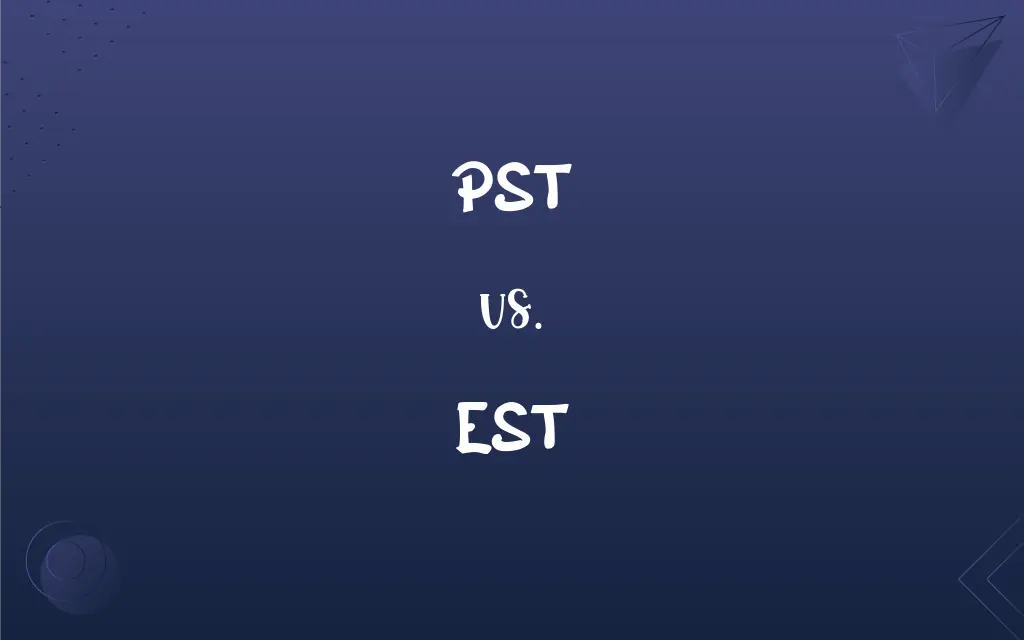PST vs. EST: What's the Difference?
Edited by Janet White || By Harlon Moss || Published on November 28, 2023
PST (Pacific Standard Time) is the time zone covering parts of western North America, 8 hours behind UTC. EST (Eastern Standard Time) is the time zone for parts of eastern North America, 5 hours behind UTC.

Key Differences
PST, or Pacific Standard Time, is observed in the western regions of North America, including states like California and Washington. EST, or Eastern Standard Time, is used in the eastern regions, including states like New York and Florida. Both are part of the North American time zone system.
PST is 8 hours behind Coordinated Universal Time (UTC-8). In contrast, EST is 5 hours behind UTC (UTC-5). This difference means that when it is noon in PST, it is 3:00 PM in EST, demonstrating a three-hour time difference between the two zones.
During daylight saving time, PST changes to Pacific Daylight Time (PDT), advancing by one hour to UTC-7. Similarly, EST becomes Eastern Daylight Time (EDT), moving to UTC-4. This daylight saving adjustment aligns both time zones more closely with daylight hours.
PST covers regions like California, Washington, and parts of Canada like British Columbia. EST encompasses areas including New York, Florida, and parts of Canada like Ontario and Quebec. The geographical spread of these time zones influences various aspects like broadcasting and travel.
PST and EST are critical for scheduling in the United States. Businesses and individuals planning meetings or events must consider the three-hour difference to coordinate effectively across the country. This time difference is especially pertinent in fields like broadcasting, where live events are often scheduled according to Eastern Time.
ADVERTISEMENT
Comparison Chart
UTC Offset
UTC-8
UTC-5
Daylight Saving
Shifts to UTC-7 (PDT)
Shifts to UTC-4 (EDT)
Key Locations
California, Washington
New York, Florida
Standard Time Period
November to March
November to March
Business Impact
Affects scheduling in western regions
Influences eastern region scheduling
ADVERTISEMENT
PST and EST Definitions
PST
PST refers to the time zone used by the western part of North America.
The conference call was scheduled for 10 AM PST.
EST
During daylight saving time, EST changes to Eastern Daylight Time (EDT).
Clocks are set one hour ahead when transitioning from EST to EDT.
PST
PST is observed in regions like California and Washington.
TV shows often air at different times in PST compared to EST.
EST
EST refers to the time zone observed in the eastern part of North America.
The meeting was set for 3 PM EST.
PST
PST stands for Pacific Standard Time, which is 8 hours behind UTC.
The flight from Los Angeles landed at 6 PM PST.
EST
EST stands for Eastern Standard Time, which is 5 hours behind UTC.
The New York stock exchange opens at 9:30 AM EST.
PST
During daylight saving time, PST changes to Pacific Daylight Time (PDT).
We switch from PST to PDT in the spring.
EST
EST is used in areas including New York, Florida, and parts of Canada.
Television prime time in EST differs from that in PST.
PST
PST impacts various activities, including broadcasting and travel.
The webinar was live at 9 AM PST for West Coast attendees.
EST
EST is crucial for scheduling across different regions in the U.S.
The national news airs live at 6 PM EST.
PST
Alternative form of psst
EST
(obsolete) Grace; favour.
PST
Standard time in the 8th time zone west of Greenwich, reckoned at the 120th meridian west; used in far western states of the United States
EST
Abbreviation of established
EST
Init of w:Erhard Seminars Training, a course intended to promote satisfaction with life in the present moment, as opposed to strivings to attain it.
EST
East.
EST
Standard time in the 5th time zone west of Greenwich, reckoned at the 75th meridian; used in the eastern United States
FAQs
What does EST stand for?
Eastern Standard Time.
Which states primarily use PST?
States like California and Washington.
What does PST stand for?
Pacific Standard Time.
What is the UTC offset for PST?
UTC-8.
Which states primarily use EST?
States like New York and Florida.
When does EST change to EDT?
Also during Daylight Saving Time.
How does the PST to EST time difference affect broadcasting?
Shows are often broadcast live in EST, then replayed in PST.
What is the UTC offset for EST?
UTC-5.
What is the main advantage of understanding PST and EST?
It helps in scheduling and coordinating events across different regions.
Do all states observe Daylight Saving Time changes in PST and EST?
Most do, but there are exceptions like Arizona and parts of Indiana.
Can someone in PST have a business meeting with someone in EST?
Yes, but they need to coordinate the three-hour time difference.
How do airlines handle PST and EST?
Flight times are often scheduled and communicated in local times.
Is the time difference between PST and EST always the same?
Yes, it's consistently a three-hour difference.
When does PST change to PDT?
During Daylight Saving Time, typically in spring.
Does the internet use PST and EST?
Yes, especially for live events and server reset times.
How do international businesses manage PST and EST?
They often schedule meetings considering these time zones.
Is it common for TV shows to air at different times in PST and EST?
Yes, to accommodate viewers in both time zones.
Are there any challenges with PST and EST in global communication?
Time zone differences can make real-time communication challenging.
Are PST and EST observed in Canada?
Yes, in regions like British Columbia (PST) and Ontario (EST).
Do PST and EST affect online gaming?
Yes, game events are often scheduled according to these time zones.
About Author
Written by
Harlon MossHarlon is a seasoned quality moderator and accomplished content writer for Difference Wiki. An alumnus of the prestigious University of California, he earned his degree in Computer Science. Leveraging his academic background, Harlon brings a meticulous and informed perspective to his work, ensuring content accuracy and excellence.
Edited by
Janet WhiteJanet White has been an esteemed writer and blogger for Difference Wiki. Holding a Master's degree in Science and Medical Journalism from the prestigious Boston University, she has consistently demonstrated her expertise and passion for her field. When she's not immersed in her work, Janet relishes her time exercising, delving into a good book, and cherishing moments with friends and family.







































































